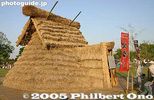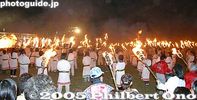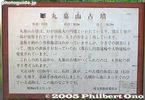 Image search results - "saitama," Image search results - "saitama," |

One of two giant kitesThis festival has two giant kites and two smaller (but still large) kites. Resting on its side, the kite was scheduled to fly at 2 pm. The kanji characters read "Michi no Eki" in reference to a new train station built in the town.
|
|

Festival's focal pointThis grass hut is at the center of the festival site which is within the Sakitama Tumuli Park. It will be burned later in the evening for the festival's climax.
|
|
|

Offerings
|
|
|
|

Festival siteIt is a circular site with people sitting along the perimeter.
|
|

Lowering the kite
|
|

SpectatorsThese people are sitting in the best area to view the festival.
|
|
|
|

EntertainmentAn outdoor stage provides a variety of entertainment during the day.
|
|
|

Festival participantsThey are dressed in the costume of the ancient Kofun (Tumuli) Period of Japan. They will be carrying torches from the nearby tumuli.
|
|

Patch up
|
|

TumulusCherry trees are at the top.
|
|
|

Shinto ceremonyAt around 6:30 pm, the festival climax starts.
|
|

Moving the kite to launch point
|
|

Torch bearers enter
|
|

Festival siteThey did not allow people go enter the launch area at all times. Spectators were kept far away.
|
|

Marvelous spectacle
|
|
|
|

Parade aroundThe torch bearers parade around the entire perimeter before they gather around the hut.
|
|

No people on the sides either
|
|
|

Launch point on a low hill
|
|

Male prince
|
|
|

Female princess reigning over the Sakitama Fire Festival in Gyoda, SaitamaShe's 15 years old.
|
|
|
|
|

Ride'em cowboyAs the kite quickly flew up, the forward kite pullers had to release the rope.
|
|

Torch lightingThe prince and princess light the torch that will ignite the hut.
|
|
|
|

Climax
|
|
|
|
|
|
|

Michi no EkiThe kite design is the same every year, but the kanji characters change. They make a new giant kite every year.
|
|

Torch bearers from the tumulus
|
|
|
|

Stage ceremonyThe torch bearers gathered in front of the stage where there were speeches and cheers.
|
|
|

FireworksThe festival ended at 7:30 pm.
|
|
|
|
|

Smaller kite "Yujo"
|
|
|
|
|

"Yujo"This is a smaller kite. It means "Friendship."
|
|
|
|
|
|
|
|

She fell
|
|

Patch up
|
|
|
|

"Nakama"This is another smaller kite. It means "Circle of Friends."
|
|

Anchor truck
|
|

Amateur areaFurther downwind was the amateur area for flying normal kites.
|
|

Another launch
|
|
|
|
|

Another beautiful take off
|
|
|
|
|
|
|
|

Poster
|
|

Park mapThe park has numerous tumuli as well as an archeological museum.
|
|

Inariyama TumulusPeople are allowed to climb up the tumulus.
|
|

Inariyama Tumulus
|
|

Maruhaka-yama TumulusThis is Japan's largest round tumulus (also used during the Fire Festival).
|
|

Maruhaka-yama TumulusCherry trees are at the top.
|
|

Maruhaka-yama Tumulus sign
|
|

Shogun-yama Tumulus
|
|

Kawarazuka Tumulus
|
|

Futagoyama Tumulus
|
|

Giant Kite MuseumLocated a short walk from the kite festival site. This is also where you can catch the bus back to Kasukabe Station.
|
|

Older giant kite "Odako"The museum displays giant kites from previous years. Usually the giant kites are destroyed after the festival. But a few of them have been preserved here. The kanji means "Giant Kite."
|
|
|
|
|

Smaller kitesThe museum displays many different kites from all over Japan and other countries.
|
|
|

Museum floorThis is where they make the giant kites during Feb. to April.
|
|
|
|